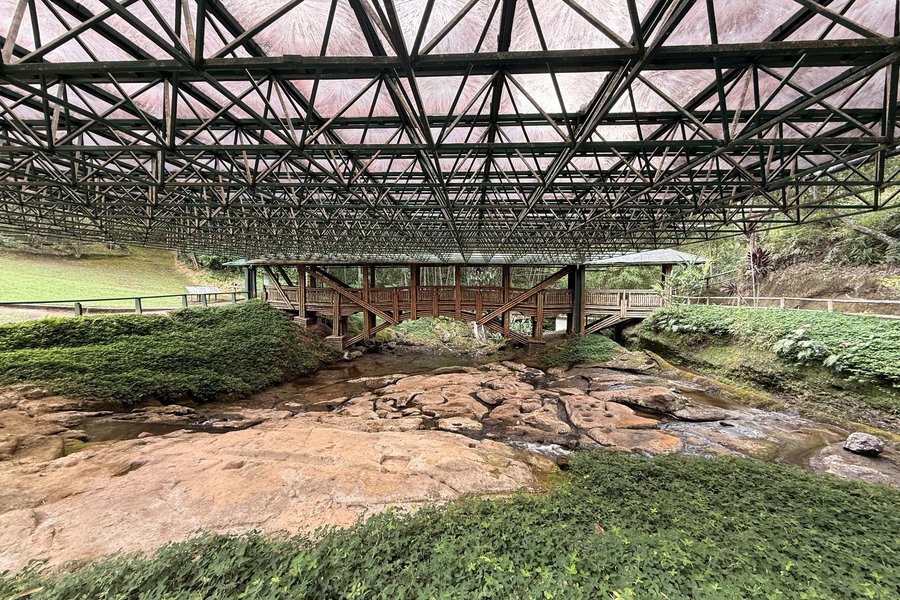
General Information
San Agustín has been covered thoroughly, but I tried a new approach to reaching the site, which I believe can cave future visitors a lot of time and money, so I’m writing this review to highlight that. I’ll also share general impressions of the site.
Getting There
I did not have much time to visit, so I had to get creative because I wanted to fit both Tierradentro and San Agustín in 3 days. Having read the reviews, I knew I could fly to Popayán and then hire a private tour. I contacted several tourism companies and the best they could offer me is both sites for $500 (on top of the flight to Popayán) one day each, with each day involving very early days and 3-4 hour of driving each way. The amount of hours in a car and the cost deterred me from this option. On the other hand, I also considered taking public transport; but knowing I had very limited time, and how unreliable public transport is in the area, I decided this wouldn‘t be an option for me either.
Instead, I noticed there are 2 daily flights between Bogotá (BOG) and Pitalito (PTX), a relatively smaller city that is only 30 min away from San Agustín via car. Since I also wanted to visit Tierradentro, I rented a car from a local company called Presta Cars, which gave me a lot of freedom to go as I please between locations. I covered more of …
Keep reading 0 comments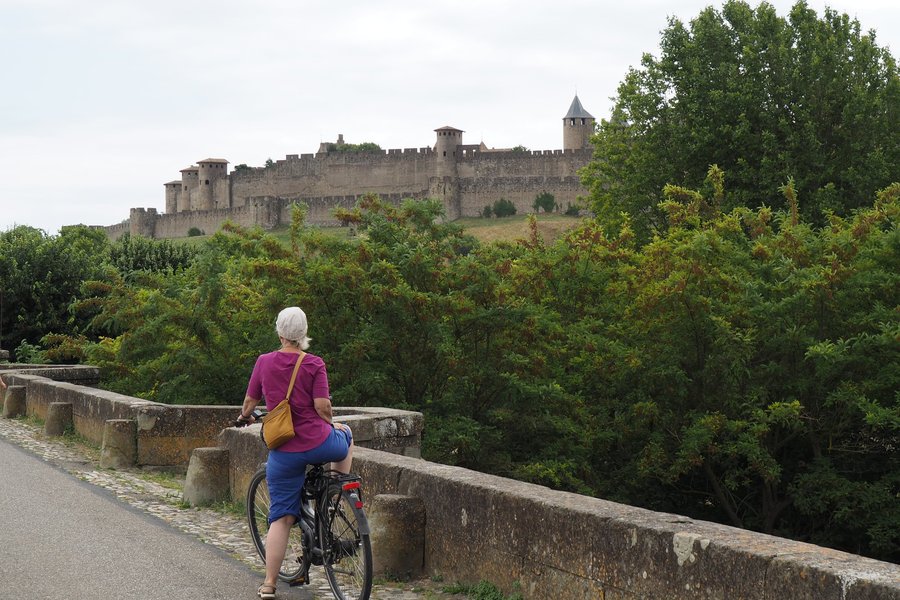
There are 14 texts before mine and the vast majority of them are rather positive.
I had already visited the walled city as a child with my parents and then later a second time with my children, but in 2023, my wife and I returned with the WHS filter in our eyes.
We arrived by bike from the Canal du Midi, crossed the new town from the canal port and the old bridge (the introductory photo) then climbed the slope to the main entrance of the old town, on the east side, where a priest was blessing bikes and cyclists, strange!
And since you cant' teach an old dog new tricks, seeing a delirious crowd crowding at the entrance to the City where buffoons were clowning around in period costume,
We decided to let the tourists crowd into the narrow streets while the cyclists toured them peacefully... via the lices (Double rampart), which is great because there aren't many remains of this type left in Europe. And their size is impressive!
I will not return to the controversy surrounding Viollet-le-Duc's interpretation of the medieval fortified town, contrary to the theories of John Ruskin, but it should be noted that his idealized approach is the very foundation of modern heritage conservation methods, a counter-reaction to his work, if I may say so! The best thing to do is to go and see his greatest achievement, in the Oise, the Château de Pierrefonds, which he almost entirely rebuilt. And we must not …
Keep reading 0 comments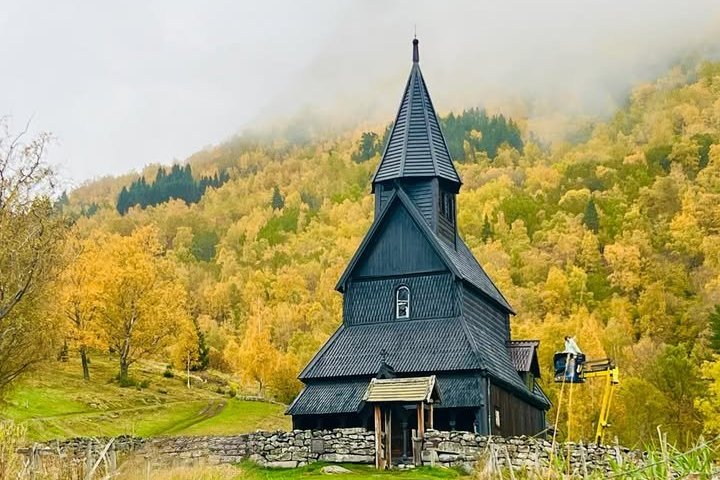
My friends and I began our visit to the Urnes Stave Church in the small town of Sogndal, nestled deep within Norway’s fjord country. Most travelers heading to Urnes would simply drive to the nearby village of Solvorn and take the short ferry across the Lustrafjord to Urnes or Ornes. But instead of following the usual route, we decided to take the long way around, driving along the fjord through Skjolden and looping down the opposite side toward Urnes.
It turned out to be one of the most memorable drives of our trip. The road was narrow and winding, hugging the edge of the Lustrafjord as it curved through small farms, forests, and quiet hamlets. Often it narrowed into a single lane where two cars could barely pass. The scenery was breathtaking: steep green slopes plunging into deep blue water, occasional glimpses of waterfalls, and scattered wooden houses clinging to the hillsides. At times, the road led into dark, one-lane tunnels carved straight through the rock, where headlights illuminated only a small circle ahead. The air inside felt cool and damp. It was nerve-racking, yes, but also strangely beautiful. As we approached the small village of Ornes at the end of the fjord, the road climbed gently uphill through clusters of houses and farms. Only then did the Urnes Stave Church come into view, a modest, dark wooden structure standing quietly on the slope above the fjord. From a distance it looked simple, almost humble, but up close its details …
Keep reading 0 comments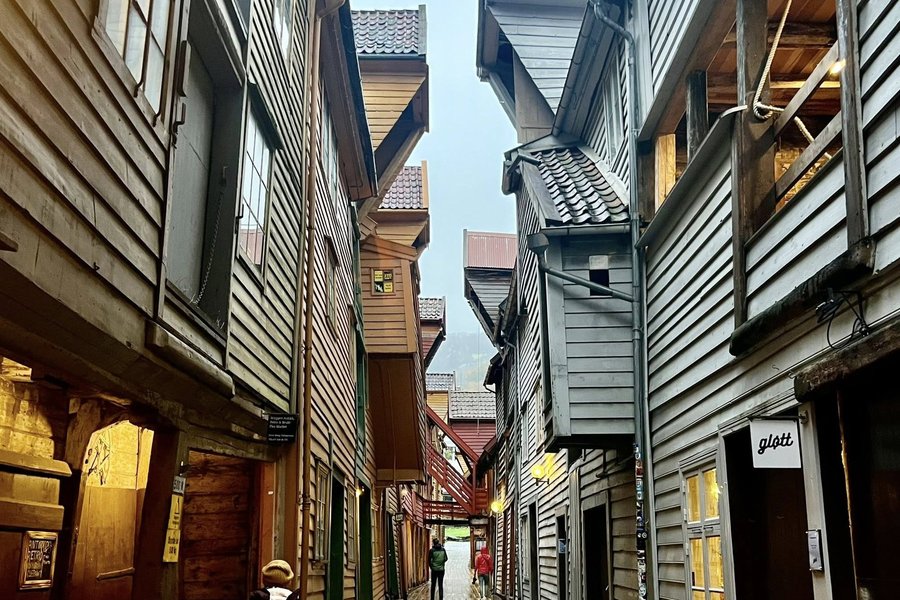
When I first arrived at Bryggen in Bergen, my impression was simple: a picturesque row of colorful wooden houses lining the harbor, the kind of view that perfectly fits a postcard of Norway. Their neat gabled facades, painted in warm reds, ochres, and whites, seemed to be all there was to this UNESCO World Heritage Site, beautiful remnants of the Hanseatic League’s trading past, preserved for modern admiration. I thought Bryggen was merely a charming backdrop for photos, a historic façade telling a simple story of bygone merchant prosperity.
Luckily, my hotel was located just next to Bryggen, which allowed me to explore it at different times of the day. During the daytime, the site is undeniably crowded and touristy, with groups of visitors filling the waterfront to take photos of the iconic colorful buildings. Most tourists stop there, admiring only the façade from the harbor without realizing that behind it lies an entirely different world. Yet if you take the time to slip through one of the narrow alleyways, the atmosphere changes immediately. Behind the lively facade, Bryggen becomes surprisingly quiet and peaceful. The sound of the harbor fades, replaced by the creak of old timber and the soft echo of footsteps on worn wooden planks. The buildings themselves feel alive, walls slightly leaning after centuries of standing, beams darkened by rain and sea air, and roofs sagging gently with age. Some structures tilt toward each other so closely that the alley narrows into a tunnel of …
Keep reading 1 comment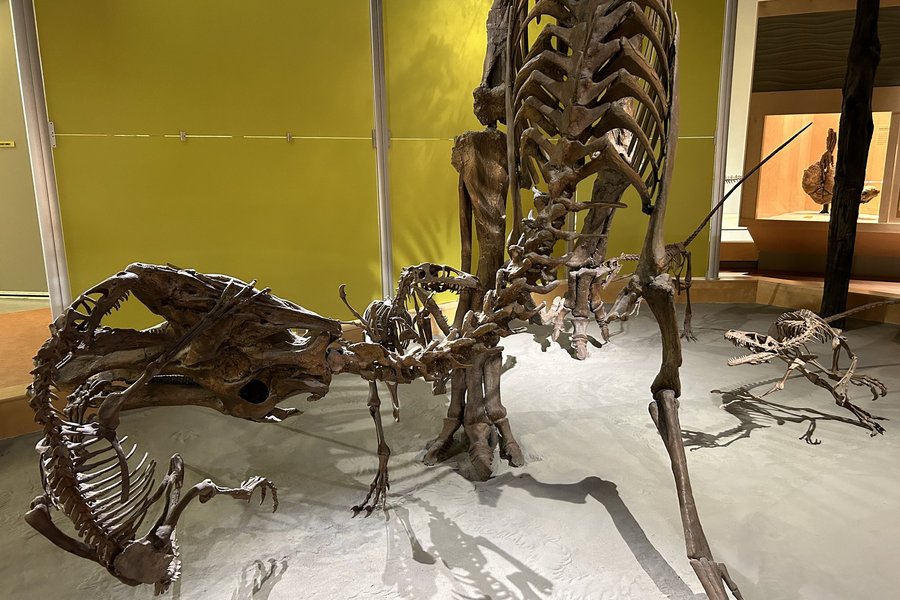
This is an excellent site for Cretaceous dinosaur fossils. Once a semi-tropical coastal plain, now the dry badlands erode rapidly with every rainfall, continuously revealing new fossils, many of which have been reassembled at major museums. While there’s camping and a self-drive loop, the majority of fossils are only seen on guided tours. That’s great, because the guides let you sit right among the fossils and even pick some small items up carefully, before returning them to the site. I held a 75 million year old T-Rex tooth in the palm of my hand—one of my favorite WHS experiences: https://zct.life/2023/08/11/dinosaur .
Compared to other fossil sites, this site is welcoming, accessible and hand-on. I learned a great deal from the guide, including skills like how to look for, find, and identify fossils which I have used with some success elsewhere. While Dinosaur National Monument in the US has some exceptional exhibits, such as a fossil wall, and is in a beautiful large park, I enjoyed the Canadian WHS due to the personal interaction. Here you feel like a paleontologist, and maybe you’ll discover something new when you visit.
Keep reading 0 comments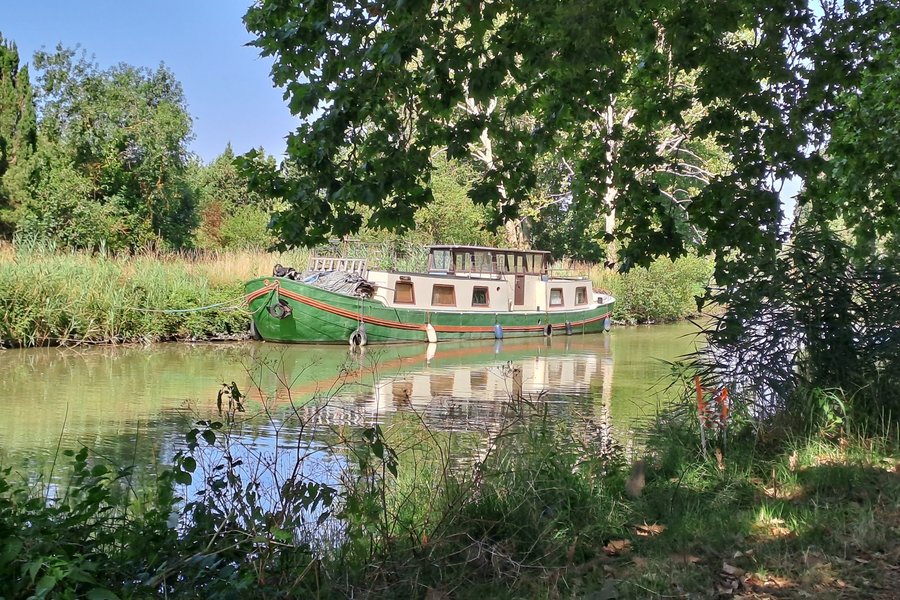
A WHS as we like them because, like the Loire Valley, it combines nature, culture and sport!
And since we don't have sea legs, we traveled it by bike in 2023. The pleasure of this means of transport along a canal: it's completely flat, you don't get tired.
Like the other writers on WHS.org, given the length of the site, we had to make a choice and our choice fell on the region of Castelnaudary and Toulouse, firstly in memory of my youth because I had already been there a long time ago to go hiking in the Montagne Noire, then because we had never visited Toulouse before.
The place lived up to our expectations. The canal is magnificent, bucolic, and above all, relaxing. Nothing is more pleasant than sitting on a bench watching the barges in a lock, or reading why and how the canal was built, which I won't dwell on: others have done it very well before me.
One of our excursions from the campsite, where we enjoyed an excellent, family-style cassoulet, originating in Castelnaudary, was to the Saint-Férréol reservoir. The idea was to see the watershed that feeds the canal. There isn't much to see there, as the lawn has replaced the reservoir water, but there is still a nearby memorial column, "La pierre de Riquet" (the canal's engineer-designer), lost in the middle of nowhere, which added to my enjoyment.
The Castelnaudary region is a good base for visiting Toulouse, where there is also St-Sernin, listed …
Keep reading 0 comments
Please bear with me as this is my first time writing a review
Having visited other relatively remote WHS properties in the past, I wasn’t necessarily intimidated by the challenges already pointed out by other travelers, but I tried some new approaches that I think could be helpful for anyone planning to visit now.
Overall Review of the Site
The property spans 5 locations spread out across 3 mountains. Alto de Segovia is, by far, the most impressive with the highest number of hypogea. Out of the other four, El Tablón does not have any hypogea but rather 9 megalithic figures, making it different from the rest, although not necessarily impressive (especially if you’ve visited San Agustín or Quirigua). The Alto de Segovia, Alto del Duende, and El Tablón are easy to reach, but do require a slight hike. Alto de San Andrés does require a muddier hike on a separate mountain, and Alto del Aguacate requires the most strenuous and longest hike, requiring you to reach yet another mountaintop. The hypogea themselves are interesting in their own right, as they are pretty unique, mixing elements of megalithic building (such as at the Antequera Dolmens) with ancient wall painting. Having visited almost every other pre-Hispanic WHS, I have not seen anything similar. Although not necessarily the most impressive thing to view, the setting and the history of the site do help understand the site’s OUV and appreciate the rituals of this yet-to-be-named culture.
Getting There (and Back)
I had read …
Keep reading 1 comment
Another WHS site in France, another Gothic cathedral.
With its original features, Sainte-Cécile d'Albi has nothing to do with the one in Bourges, which we visited the same year. Where we visited the archetypal Gothic cathedral, here we discover a completely atypical cathedral built with no fewer than 25 million bricks, a rather rare occurrence for a cathedral in France! Unlike stone, this material does not allow for much imagination, which is probably what gives it its austere appearance at first glance. However, the more recent exterior buttresses and choir turrets give it majesty and slenderness.
This magnificent monument offers a wonderfully colorful interior world, still displaying its original rood screen (15th century), a veritable stone lacework that somewhat disrupts the reading of the interior volume of the cathedral-hall (that is, without side aisles). We crane one's neck to admire the 16th-century paintings on the walls and ceiling: a pure marvel (The photo).
It is like a precious stone carefully placed in the velvet of its jewelry box, but let us not forget that the defensive aspect of the cathedral and the other buildings of the archiepiscopal city of Albi are the trace of a succession of ecclesiastical betrayals, murders, powers assumed and claimed in the aftermath of the crusade against the Cathars...
It's a real discovery to be made, to drag your trainers around the episcopal city with a view of the Tarn (The photo) and through the alleys of the old town, then to enjoy the good weather …
Keep reading 0 comments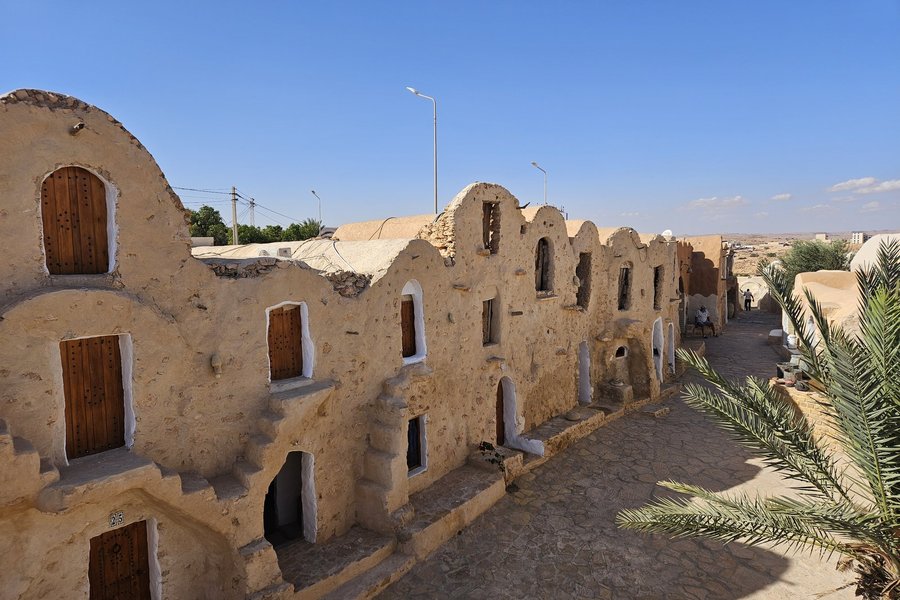
Ksar Hedada might be off the TWHS, but it is probably the most visited site in the region. The Ksar was used as filming location for Star Wars: Episode 1 (representing Mos Espa, the birthplace of Anakin Skywalker, for those into Star Wars) and that is why it is popular with visitors. Half of the Ksar was heavily reconstructed and now includes some shops and a restaurant. Entrance fee is 2 Dinar and you can explore the reconstructed, as well as the untouched part.
It’s not clear to me, why this Ksar had been removed and is not part of the current TWHS, that includes many other Ksars in this region. In terms of partial reconstruction it’s exactly the same level as Ouled Debbab (the reconstructed part is housing a museum, a restaurant and a hotel) or Jouamaa (the whole complex is a currently closed hotel).
Keep reading 0 comments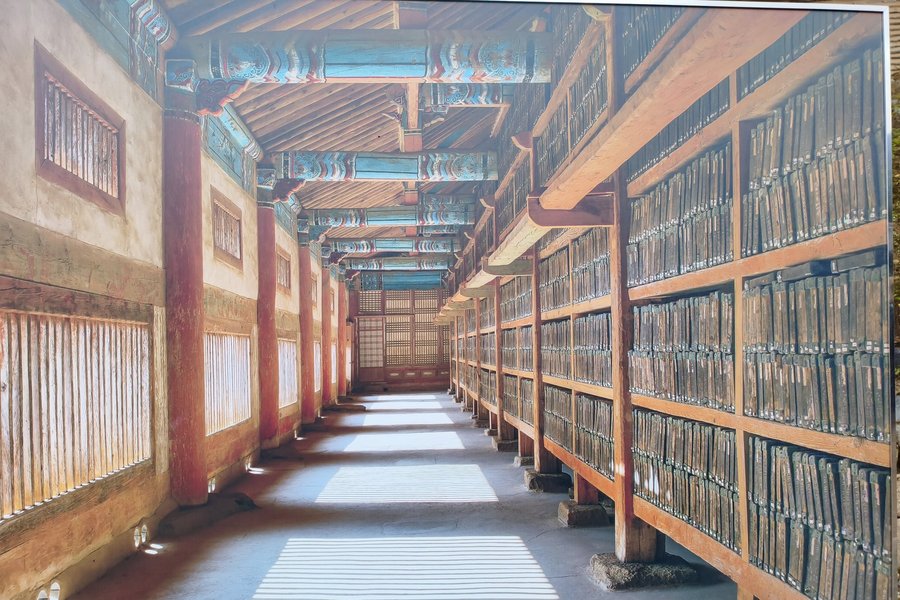
Time of the visit: the 16th of oct.,2025
In the morning I took a KMX train from Busan to Daegu-Dongdaegu,from there I had to take the metro to get to Daegu's Seobu Bus Terminal.There is an hourly bus going to the Haeimsa temple via Goryeong.All buses of that fixed route stop there.
I got off one stop before the final stop, as from there you can walk directly up to the temple complex. The temple is massive and consists of many sub-temples. I first went to the halls where the Tripitaka Koreana is housed, a complete collection of Buddhist scriptures in Chinese language carved onto over 80,000 wooden printing blocks.You can take a look through the wooden bars, but you can't see much.An oversized photo of the interior can be viewed directly outside the storage halls.
I then visited most of the sub-temples.There are two cafes inside the temple premises.I had one needed coffee in one of them.All in all I stayed more or less 3 h inside the temple complex.I missed some of the side temples,but had the feeling that I had seen enough to get a good overview of that whs.Surrounded by beautiful mountains and crossed by beautiful streams, Haeinsa remains an active center of Korean Seon (Zen) Buddhism and a symbol of Korea’s rich cultural and spiritual heritage.Regardless of the high importance for the Koreans and Buddhism in general I for my part found the Tongdosa temple complex near Busan far more impressive.
On the way back …
Keep reading 0 comments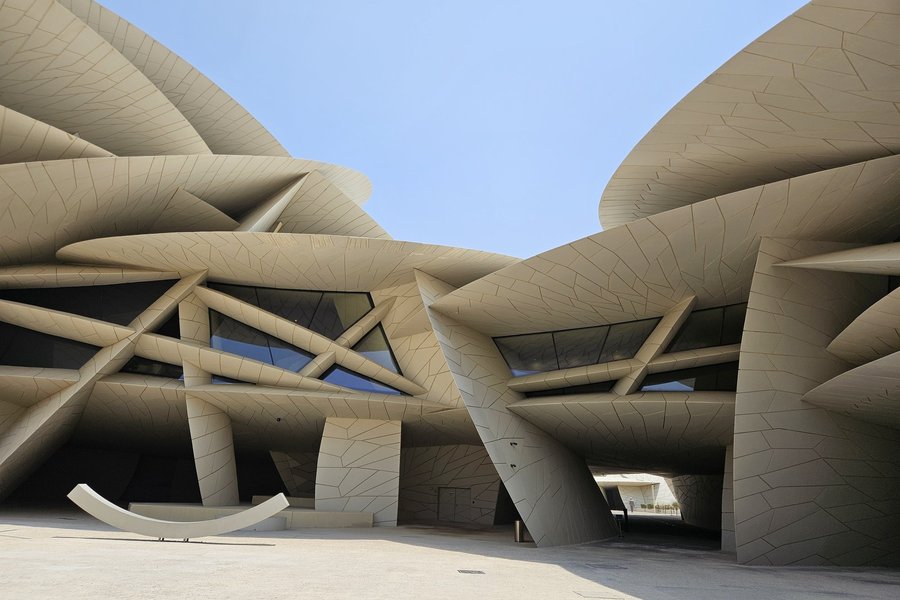
When I visited during an unplanned stopover in July 2025, I had given this already a thumbs down, before I even stepped foot into the museum. There was no way, that a building from 2019 would already become a WHS.
Upon arrival I had to admit, that the building looks impressive and amazing. The desert rose shape is clearly visible and even though the whole complex is massive, it feels good to wander around. There was some minor renovations going on and I had trouble to find the entrance. Entrance was free and the exhibition, as mentioned by Els, very impressive. Everything is top notch, with interactive elements and spacious rooms. It is kind of funny, that a country I would describe as rather boring is presenting itself in such an interesting way.
The palace is a cool feature, but it is so heavily restored, that I (no, I did not do any kind of research before visiting) thought it was fake, before reading the information boards.
Did I change my mind after the visit? Yes, I did. The building is new. But Qatar is new. I only looked at it from a European perspective, where we have tons of sites from 50’000 years of human activity. But that’s not the right angle. There is not much left from the really old sites, like Al Zubarah or Al Da’asa. Something like the national museum would represent Qatar and the history and identity of the region much better. So yes Qatar, …
Keep reading 0 comments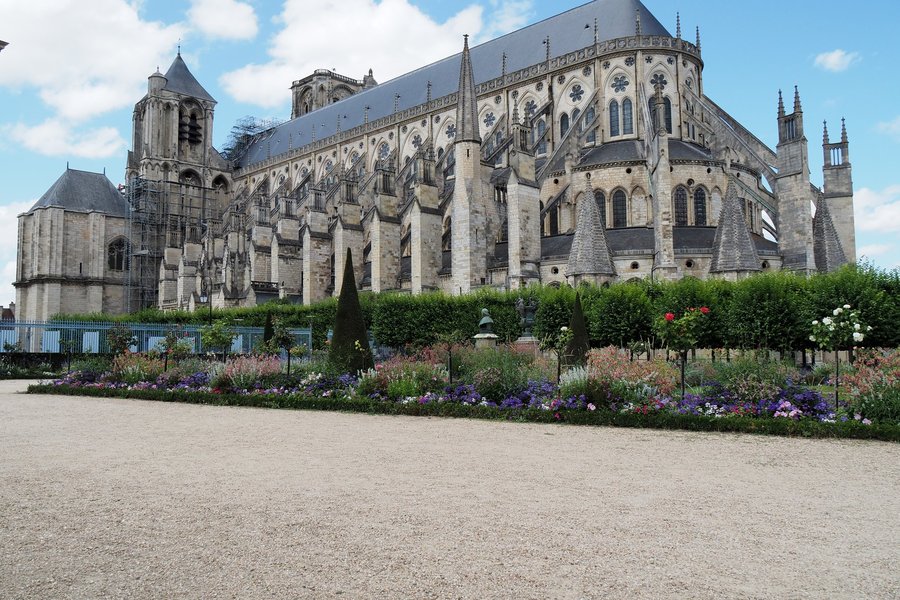
It's not easy to reach the old town of Bourges by mobile home. We had to leave it at the bottom of town along the Auron River and walk back up.
What we discover is the archetype of the Gothic cathedral, with its long nave, its slender windows, its flying buttresses, a gigantic stone vessel stranded in the city... Historians agree that "the building is remarkable as much for its harmonious proportions, linked to the unity of its design, as for the quality of its tympanums, its sculptures and its stained glass windows" (Wikipedia).
As far as sculptures and stained glass are concerned, many other Christian buildings can rival this one, but it is true that the unity of its construction (from 1195 BC to 1324 BC) is clearly visible (Introductory photo). Unfortunately, the discovery of this ogre did not leave us with an indelible memory. This is only a question of personal feeling, which does not in any way detract from the plastic and historical quality of this building, of course.
So why Bourges WHS when there are those of Amiens, Chartres, Reims and Soissons built at the same time in the same style, including Amiens, Chartres and Reims listed as UNESCO World Heritage Sites?
Is it different? Is the difference such that it justifies an "exceptional" quality? The answer is yes and no. After comparing the plans of each of these cathedrals, we can read that the Saint-Etienne Cathedral of Bourges is a variant of the …
Keep reading 0 comments
When researching visiting Mt Athos as part of my UNESCO Journey, I thought this was going to be one of my more difficult ones to achieve. I am not religious and can be best described as Agnostic with values and due to the actions of my parents baptising me for their beliefs, qualified me for entry under the "visiting pilgrim" of a different faith other than Greek Orthodox. I did however feel like an imposter as I was visiting to experience the Cultural and History of Mt Athos, not the religious aspect. Only 10 Non-Greek Orthodox visitors and 100 Greek Orthodox visitors can visit per day.
I reached out about 12 months prior to travel via email athosreservation@gmail.com to the reservation office to try and obtain my entry permit, a Diamonitirion, only to be told that they do not take bookings that far in advance and to recontact them 3 months prior to my planned visit. I set my calander and did so to the day. I had a week period based in Thessaloniki and when I recontacted them back, there was only 1 spot available over that week period and this was the 8th of October 2025. A copy of my passport was required to verify my idenity and they wished to know my baptised religion. I was advised to pick up my Diamonitirion on the morning of my visit and if I wished to stay at particular monasteries that I was to liaise with them prior to travel, …
Keep reading 3 comments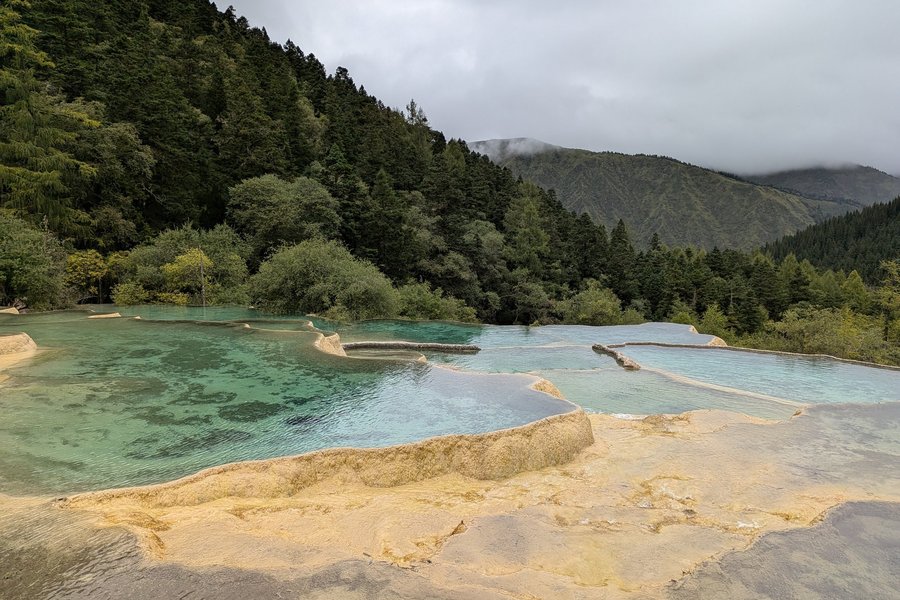
Our initial glimpses of Huanglong were, truth be told, a touch anticlimactic. We'd ascended via the cable car and found ourselves on the first viewing platform. Compared to the turquoise pools of Jiuzhaigou the day prior, it all looked rather small and decidedly brownish. The day's cloudy weather probably didn't help.
Eventually, we reached the cascades. From there, it's a climb to reach Wucai (Five-Colour) Pond and the primary temple, Huanglong Ancient Temple. Even at this stage, the views hadn't quite grabbed me.
It was only as we began the descent that the site truly started to come into its own. The water tumbles downhill through a myriad of calcite pools and cascades. The Chinese authorities have done a superb job of creating boardwalks, allowing you to walk right alongside—or, indeed, directly over—the water flows.
If you compare Jiuzhaigou to Huanglong, I found Jiuzhaigou the richer experience while cascades at Huanglong are the more outstanding individual feature. The other obvious comparison also made by Els is to the pools at Pamukkale. Huanglong, however, feels far more like a natural site, and the environment seems better preserved than its Turkish counterpart. Given the Taoist temples on site and the Taoist significance, I was wondering if this shouldn't be a mixed site.
Getting There
Thanks to the high-speed rail connection to Chengdu, a day trip is technically possible, making it an addition to your Chengdu Hotspot. However, it's not a terribly sensible option, as you really ought to visit the nearby Jiuzhaigou, …
Keep reading 0 comments
The first thing that surprised and slightly disappointed me was that no one checked my visa for visiting Mount Athos anywhere.
By 5:30 a.m., there was already a huge line outside the office that issues visas to pilgrims. Visas are issued fairly quickly, so by 6:15 a.m., I was able to get one. I immediately bought a ticket for the 6:30 ferry at the ticket office next to the pilgrims' office. The ticket costs €8. It takes about five minutes to walk to the ferry. No one asked for or checked my visa either at the ticket office or on the ferry.
Even though it had been raining all morning, the ferry to Daphne stopped three or four times at different stops. We finally arrived in Daphne at 9:00 AM. And even here, no one asked for a visa: it was truly disappointing...
Google indicated that the walk to Xeropotoma Monastery should take two hours, but completely by chance I discovered a very convenient stone-paved path that took me to the monastery in 30 minutes. The monastery was closed, but I could explore it from the outside and take some good photos. My path then led to the capital of Mount Athos and the monastery of Klouthmonosi. Unfortunately, the rain continued to pour, and my route (according to Google) included both paved roads and dirt paths. It took me two and a half hours to reach the capital on foot. I didn't encounter a single pilgrim the entire time: they …
Keep reading 2 comments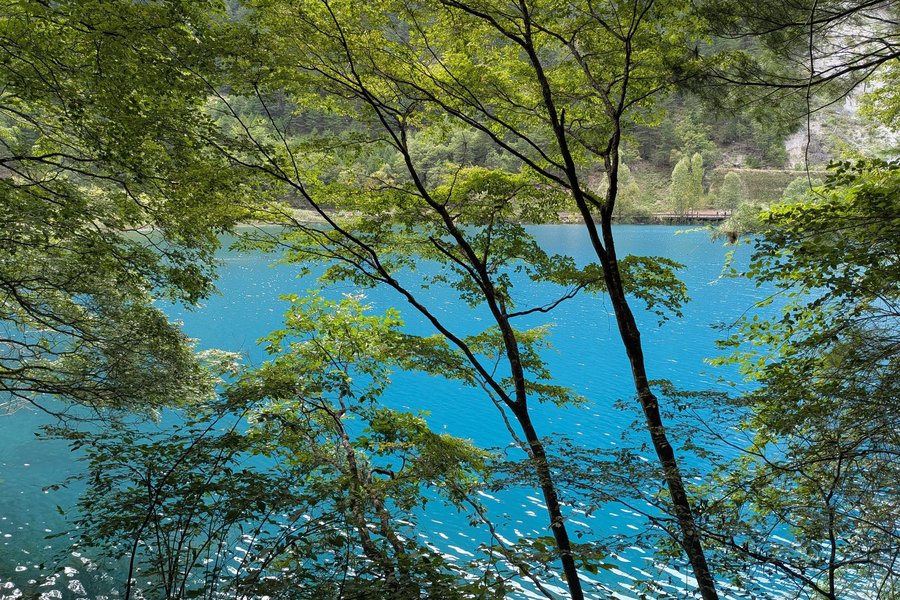
Jiuzhaigou is a water-and-mountain wonderland, bursting with turquoise pools, breathtaking mountain vistas, and spectacular waterfalls. It's not without reason that it ranks as China's top Natural World Heritage Site and one of its top four overall.
We spent a day hiking in the park. From the park entrance, we took the shuttle bus up to the Primeval Forest bus stop at 3200 meters altitude, then followed the water's flow down to the Nuorilang Falls, and ended our visit in the Tibetan village of Shuzheng. Admittedly, some legs we hopped onto the shuttle bus as shortcut.
Our original plan was to spent 1.5 days in the park. We had arrived from Chengdu by lunch time the day prior and were hoping to visit the lower parts of Jiuzhaigou in the afternoon. However, we discovered that the park had already stopped selling tickets for the day. This highlighted a crucial point: tickets must be bought online and in advance.
What initially felt arbitrary turned out to be the park's method of crowd control. Jiuzhaigou is immensely popular with domestic tourists, and to protect the fragile natural environment, strict limits are enforced, including a daily visitor cap.
This brings me to the main challenge for anyone who has experienced other great national parks. In vast places like many American parks, where visitor numbers are low relative to the size - I recall having Los Alerces mostly to myself - you get more freedom and the visit feels more intimate.
In China, this system …
Keep reading 0 comments
We visited Nyungwe National Park on a day trip from Kamembe, but in retrospect, we really should have stayed longer. The forest is absolutely stunning – said to be one of the oldest rainforests in Africa and a true hotspot for biodiversity. It was the most beautiful forest we saw on our trip, with ancient, moss-covered trees, steep and rugged terrain, and several viewpoints overlooking the “broccoli-topped” hills and valleys.
The park is home to a remarkable variety of wildlife, including 13 different primate species. We only saw two – the Colobus and the L’Hoest’s monkeys – but even that was a treat.
This is definitely a park for those who enjoy being active. There are many things to do, such as chimpanzee and Colobus trekking. We didn’t try any of these since we had already done chimp trekking earlier on our trip. However, we met people who had, and while they described a long trek before finding the chimps, many said the Colobus trekking was very rewarding. You can also join a night walk. The ranger told us, that they are introducing gorillas in the park and that they will offer gorilla trekking in a few years.
There is an impressive network of trails – around 130 km in total – offering hikes of different lengths and difficulty levels. Keep in mind that the park lies between 1,600 and 2,900 meters above sea level, with the Visitor Center located at around 2,400 m.
From the Uwinka Visitor Center, they’ve …
Keep reading 2 comments
On a day trip from Chengdu, we visited both Baodingshan and Beishan. We started our visit at Baodingshan. As it was our first full day in China, we still needed to groove in. We spent more than an hour trying to find the actual entry to the site. We made the beginner's mistake of relying on Google Maps which has a nasty offset (error) of 100 meters in China.
Eventually, we made our way to the Dazu Rock Carvings Museum, which is where the main visit path starts. The museum houses several pieces of Buddhist art and attempts to put the site in context with other rock carvings and grottoes across China. They also provide an extensive overview of preservation methods, highlighting that a key research question is the restoration and preservation of the original colours.
Baodingshan itself is truly great, featuring many rock carvings of different styles and sizes along the path. The Circle of Life is pretty spectacular, as is the big golden Buddha with 1,007 Hands. Here and there you still find flecks of colour, which allows you to imagine how magnificent the site would have looked in the past. Shengshou Monastery, which marks both the beginning and end of the visit, is spectacular in its own right.
After our visit, we took a Didi to Beishan. At Beishan we found a more sombre site. The main carvings are smaller and less narrative-driven. Not to be missed are the two giant Buddhas on a nearby …
Keep reading 0 comments
We visited the Vézelay basilica 20 years after Solivagant, but my wife and I had already done it 15 years earlier, hitchhiking.
At that time, the common thread of our trip was Romanesque architecture in Burgundy and Provence, the guide La France romane published by Guide Arthaud in one pocket and a few coins in the other... and we can say like Solivagant that there are other religious buildings that are just as good elsewhere in Burgundy.
But Vézelay has assets that other cities perhaps don't have? I must admit that the capitals of the Vézelay basilica are among the most beautiful in France. This is a personal point of view, of course. Vézelay is also the starting point of one of the four routes to Santiago de Compostela in France, the place where Bernard of Clairvaux preached the 2nd Crusade in the presence of the royal couple in 1146 AD, and finally, it contains the relics of the controversial Sainte-Marie-Madeleine since the 8th century, which was moved there from Provence because of the Islamic threat. And so the church is not only an abbey church but also a basilica. That's a lot.
In 2023, we went back there in memory of our bohemian days and camped with Wilson the mobile home at the municipal campsite. On the official UNESCO website, the listed area is divided into two: there is a part below the hill next to the campsite and the other which includes the village. From what I understand …
Keep reading 1 comment
When the Korean War started, the North Koreans quickly conquered the northern parts of South Korea. Seoul being very close to the border fell in 3 days (June 28, 1950, after the invasion began on June 25). To organise their defenses and continue the government, Busan, the 2nd largest city of South Korea and located the furthest from the front lines, became temporary capital from August 18, 1950 to August 14, 1953. Apart from the government many Koreans also fled from the frontlines to Busan, to evade the fighting. Due to its harbour, Busan also became the military centre, specifically of the US Americans.
The proposed nomination combines government, military and refugee sites across the city. We managed to visit several locations across Busan. On our first day, we visited the Tombstone Village. The next day, we started the day at the UN Cemetery, then took a bus to the Cowshed Village, from there we went by bus to the Temporary Palace and the Temporary Parliament (a university and museum) and peeked in at the former US Embassy, now a library. We ended our day in the former US base, Camp Hialeah, not the Busan Citizens' Park.
The Koreans do a rather good job of making the sites and the history accessible. Even the Cowshed Village has a public museum providing context (it seems CugelVance missed that one, it's marked on the map).
The president's temporary palace provides a very detailed recounting of the executive affairs of the government. Only …
Keep reading 3 comments